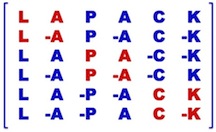 |
LAPACK 3.3.1
Linear Algebra PACKage
|
 |
LAPACK 3.3.1
Linear Algebra PACKage
|
00001 SUBROUTINE CHST01( N, ILO, IHI, A, LDA, H, LDH, Q, LDQ, WORK, 00002 $ LWORK, RWORK, RESULT ) 00003 * 00004 * -- LAPACK test routine (version 3.1) -- 00005 * Univ. of Tennessee, Univ. of California Berkeley and NAG Ltd.. 00006 * November 2006 00007 * 00008 * .. Scalar Arguments .. 00009 INTEGER IHI, ILO, LDA, LDH, LDQ, LWORK, N 00010 * .. 00011 * .. Array Arguments .. 00012 REAL RESULT( 2 ), RWORK( * ) 00013 COMPLEX A( LDA, * ), H( LDH, * ), Q( LDQ, * ), 00014 $ WORK( LWORK ) 00015 * .. 00016 * 00017 * Purpose 00018 * ======= 00019 * 00020 * CHST01 tests the reduction of a general matrix A to upper Hessenberg 00021 * form: A = Q*H*Q'. Two test ratios are computed; 00022 * 00023 * RESULT(1) = norm( A - Q*H*Q' ) / ( norm(A) * N * EPS ) 00024 * RESULT(2) = norm( I - Q'*Q ) / ( N * EPS ) 00025 * 00026 * The matrix Q is assumed to be given explicitly as it would be 00027 * following CGEHRD + CUNGHR. 00028 * 00029 * In this version, ILO and IHI are not used, but they could be used 00030 * to save some work if this is desired. 00031 * 00032 * Arguments 00033 * ========= 00034 * 00035 * N (input) INTEGER 00036 * The order of the matrix A. N >= 0. 00037 * 00038 * ILO (input) INTEGER 00039 * IHI (input) INTEGER 00040 * A is assumed to be upper triangular in rows and columns 00041 * 1:ILO-1 and IHI+1:N, so Q differs from the identity only in 00042 * rows and columns ILO+1:IHI. 00043 * 00044 * A (input) COMPLEX array, dimension (LDA,N) 00045 * The original n by n matrix A. 00046 * 00047 * LDA (input) INTEGER 00048 * The leading dimension of the array A. LDA >= max(1,N). 00049 * 00050 * H (input) COMPLEX array, dimension (LDH,N) 00051 * The upper Hessenberg matrix H from the reduction A = Q*H*Q' 00052 * as computed by CGEHRD. H is assumed to be zero below the 00053 * first subdiagonal. 00054 * 00055 * LDH (input) INTEGER 00056 * The leading dimension of the array H. LDH >= max(1,N). 00057 * 00058 * Q (input) COMPLEX array, dimension (LDQ,N) 00059 * The orthogonal matrix Q from the reduction A = Q*H*Q' as 00060 * computed by CGEHRD + CUNGHR. 00061 * 00062 * LDQ (input) INTEGER 00063 * The leading dimension of the array Q. LDQ >= max(1,N). 00064 * 00065 * WORK (workspace) COMPLEX array, dimension (LWORK) 00066 * 00067 * LWORK (input) INTEGER 00068 * The length of the array WORK. LWORK >= 2*N*N. 00069 * 00070 * RWORK (workspace) REAL array, dimension (N) 00071 * 00072 * RESULT (output) REAL array, dimension (2) 00073 * RESULT(1) = norm( A - Q*H*Q' ) / ( norm(A) * N * EPS ) 00074 * RESULT(2) = norm( I - Q'*Q ) / ( N * EPS ) 00075 * 00076 * ===================================================================== 00077 * 00078 * .. Parameters .. 00079 REAL ONE, ZERO 00080 PARAMETER ( ONE = 1.0E+0, ZERO = 0.0E+0 ) 00081 * .. 00082 * .. Local Scalars .. 00083 INTEGER LDWORK 00084 REAL ANORM, EPS, OVFL, SMLNUM, UNFL, WNORM 00085 * .. 00086 * .. External Functions .. 00087 REAL CLANGE, SLAMCH 00088 EXTERNAL CLANGE, SLAMCH 00089 * .. 00090 * .. External Subroutines .. 00091 EXTERNAL CGEMM, CLACPY, CUNT01, SLABAD 00092 * .. 00093 * .. Intrinsic Functions .. 00094 INTRINSIC CMPLX, MAX, MIN 00095 * .. 00096 * .. Executable Statements .. 00097 * 00098 * Quick return if possible 00099 * 00100 IF( N.LE.0 ) THEN 00101 RESULT( 1 ) = ZERO 00102 RESULT( 2 ) = ZERO 00103 RETURN 00104 END IF 00105 * 00106 UNFL = SLAMCH( 'Safe minimum' ) 00107 EPS = SLAMCH( 'Precision' ) 00108 OVFL = ONE / UNFL 00109 CALL SLABAD( UNFL, OVFL ) 00110 SMLNUM = UNFL*N / EPS 00111 * 00112 * Test 1: Compute norm( A - Q*H*Q' ) / ( norm(A) * N * EPS ) 00113 * 00114 * Copy A to WORK 00115 * 00116 LDWORK = MAX( 1, N ) 00117 CALL CLACPY( ' ', N, N, A, LDA, WORK, LDWORK ) 00118 * 00119 * Compute Q*H 00120 * 00121 CALL CGEMM( 'No transpose', 'No transpose', N, N, N, CMPLX( ONE ), 00122 $ Q, LDQ, H, LDH, CMPLX( ZERO ), WORK( LDWORK*N+1 ), 00123 $ LDWORK ) 00124 * 00125 * Compute A - Q*H*Q' 00126 * 00127 CALL CGEMM( 'No transpose', 'Conjugate transpose', N, N, N, 00128 $ CMPLX( -ONE ), WORK( LDWORK*N+1 ), LDWORK, Q, LDQ, 00129 $ CMPLX( ONE ), WORK, LDWORK ) 00130 * 00131 ANORM = MAX( CLANGE( '1', N, N, A, LDA, RWORK ), UNFL ) 00132 WNORM = CLANGE( '1', N, N, WORK, LDWORK, RWORK ) 00133 * 00134 * Note that RESULT(1) cannot overflow and is bounded by 1/(N*EPS) 00135 * 00136 RESULT( 1 ) = MIN( WNORM, ANORM ) / MAX( SMLNUM, ANORM*EPS ) / N 00137 * 00138 * Test 2: Compute norm( I - Q'*Q ) / ( N * EPS ) 00139 * 00140 CALL CUNT01( 'Columns', N, N, Q, LDQ, WORK, LWORK, RWORK, 00141 $ RESULT( 2 ) ) 00142 * 00143 RETURN 00144 * 00145 * End of CHST01 00146 * 00147 END